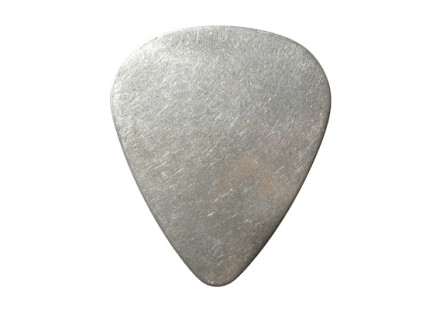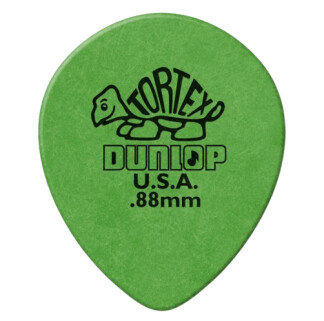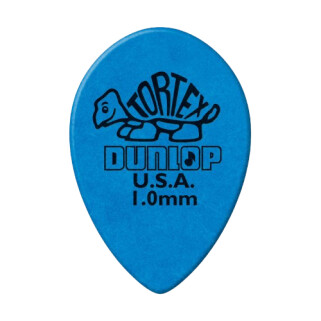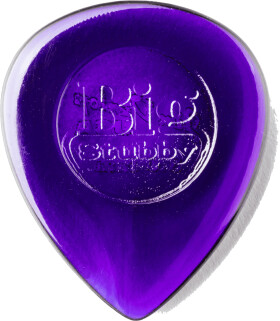The ultimate symbol and emblem of the guitarist, the pick is often forgotten when it comes to guitar sound. Yet, like all the other components in the chain, it is of vital importance. So let's explore the vast ocean of picks to give you the info you need to choose yours.

The pick influences the sound of the attack and the comfort of playing. To choose the right pick, you need to strike a balance between the tension of the strings (their pull) and the flexibility of the pick. The harder the string, the more flexible the pick. If you feel that the attack is gummed up, try a softer pick. If you feel you’re bumping into the string, you can also switch to a softer pick. Finally, if you feel that the attack is delayed, you can opt for a harder pick.
What material for the pick?
A very important aspect in choosing a pick is the material from which it is made. This material will affect the sound insofar as it will be in direct contact with the strings, causing them to vibrate in a certain way. As soon as the need for a pick became apparent, people turned to nature to find suitable materials. Turtle scales have been widely used to make picks. This material offers good resistance and a warm sound. Jazz guitarist Django Reinhardt used this type of pick for his characteristic “pompe” playing. Bone and horn were also widely used to make picks.
- Metal
Picks made from metal offer a metallic sound (yes, they do!) with plenty of high harmonics and a clean, defined attack. You’ll get different results depending on the type of metal used. Copper and brass develop the softest sounds, while stainless steel is more aggressive but also much more resistant. Metal picks are very specific and generate a sound that is just as specific. 
- Wood
Like different types of metal, different types of wood offer very different results. The Dugain brand specializes in the manufacture of wooden picks, and its catalog is packed with models built in different species. The softer the wood, the sweeter and warmer the sound. However, the pick will wear more quickly. Conversely, a harder wood such as rosewood or padauk will develop a drier sound but will last longer. A wooden pick offers an almost tailor-made sound; in fact, it’s the wear of the pick, determined by your playing, that offers a different angle of attack and therefore a different sound. Coco picks give you excellent resistance and a brighter sound than other woods.
- Bone
Bone is already used in the manufacture of certain bridge saddles. This material is highly resistant to friction and transmits vibrations very well. Bone will develop a rich, powerful sound and offers very good resistance to wear.
Plastics
- Delrin
This plastic is widely used in the manufacture of picks and is the material chosen by Dunlop for the famous Tortex. There are two types of finish on Delrin picks, gloss and matte. The matte finish gives the pick a better grip. In addition, it offers a more pronounced sound than the glossy finish, whose surface is more slippery.
.
- Ultem
This is an extremely rigid material used to produce picks with virtually no flexibility. Picks made of Ultem (we can mention Dunlop’s famous Ultex) generate a bright sound with a pronounced attack. They are solid and lightweight.
- Lexan
A transparent plastic with properties comparable to glass, Lexan is used by the American brand Dunlop for all picks in the Stubby family. This material is used for the production of very thick picks. It wears much faster than celluloid or Ultem.
- Polycarbonate
This is a polymer plastic offering greater rigidity than celluloid and nylon with a smooth surface. Polycarbonate picks, like D’Addario’s DuraGrip produce a very clean attack with plenty of impact.
- Celluloid
This has been the material used since plastic picks were first made. This material develops a balanced tone and a bright attack. The harmonics it generates will be much appreciated on a folk guitar. What’s more, its very smooth side offers a pleasant gliding sensation over the strings.
- Nylon
Used to make thinner picks, Nylon generates a fairly warm sound with few harmonics. They’re usually the first picks you try, as they’re relatively thin and supple. Nylon is, like celluloid, a very popular material since the ban on tortoiseshell.
We’ve mentioned the most common materials here, but passionate craftsmen like Riki le Plectrier, a French manufacturer of picks, offer highly original products made from materials that are just as original. You’ll find picks in solid 950 silver, Bakelite, Titanium, Galalith (also known as “milk stone”), billiard ball (yes, you will!) and even Kirinite!
 |
 |
 |
For beginning pick users, we recommend a fairly common plastic pick like Dunlop’s Tortex. You’ll have plenty of time and leisure to try out other materials once your technique is more developed.
What thickness for the pick?
The thickness of the pick will have a direct influence on its flexibility. Each material will offer different characteristics for the same thickness. The thickness of your pick will naturally affect the sound insofar as a thick pick will tend to increase the power of the attack, and vice versa. Your playing will also be impacted by different pick thicknesses. With a thinner pick, it will be less difficult to apply an even attack, whereas a thick pick will require more technical work. Finally, the lifespan of the pick will also be dependent on its thickness; indeed, a thicker pick will suffer bevel wear from repeated contact with the strings.
Pick thicknesses can be grouped into several families:
- Extra-Light: less than 0.45mm; used mainly for acoustic guitar playing
- Light: between 0.45mm and 0.70mm; widely used in “ strumming ”
- Medium: between 0.70mm and 0.85mm; the thickness most used by guitarists
- Heavy: between 0.85mm and 1.5mm; this is the thickness most suited to electric guitar
- Extra-Heavy: greater than 1.5mm; for sharper attacks and more volume
To find the thickness that will suit you best, we recommend trying several. While you’re doing so, keep your guitar sound clean so you’ll get a clearer sonic representation of the differences between various picks. In general, guitarists who play mainly acoustic or electro-acoustic instruments will tend to choose a softer pick, but this is not an absolute rule. Each brand has its own color code that expresses the thickness of the pick (at Dunlop, for example, the yellow pick is the one with a thickness of 0.73mm, the green one with a thickness of 0.88mm).
Which pick shape?
There are many pick variants on the market. The shape of the pick tip and its overall profile are the elements that change from one variant to the next. Like the material from which the pick is made, its shape and especially the shape of its tip will have an influence on the sound of the attack and playing comfort. Here are some references:
- Standard: this is the most common and widely used format. It is ideal for Rock and Blues but is perfect for many other styles.
- Triangle: these are often used by bassists or by guitarists who find it difficult to hold their standard pick properly. These picks offer the advantage of having three identical tips. So, on paper, they last three times longer than a standard pick.
- Jazz: this is a smaller pick with a pointed tip. This pick is very well suited to guitarists looking to achieve perfect control over their playing. Its small size offers a very light contact between fingers and strings, which may please some and displease others.
- Shark fin: these rather special picks like the Dunlop Fin Pick have numerous contact surfaces. This makes it possible to vary the sound simply by rotating the pick.
- Water drop: this is a type of pick much used by jazz guitarists. They offer a warmer tone and better grip. They are available in several sizes.
 |
 |
- Thumpicks and fingerpicks are small utensils that slide onto your thumb or finger, respectively. They offer a brighter sound than playing with the tips of your fingers and thumb. They also substitute for the sound of playing with long fingernails for players who don’t necessarily want to let them grow.
Beyond the pick’s shape, it’s also its tip that will help you choose the perfect pick for you. Most picks on the market come with a rounded tip, like standard picks, or with a sharper, pointed end (Dunlop’s Sharp and Jazz III models, for example). A sharper tip will enable faster, more precise playing with a sharper, brighter attack. A rounder tip will be easier to play and develop softer attacks. However, there are no hard and fast rules; virtuoso Yngwie Malmsteen uses standard 1.5mm picks and plays very fast.
Some brands like Dunlop offer variants of their picks with different coatings and textures. In fact, the American brand offers a “Max Grip” variant, whose surface in contact with the fingers is specially designed to grip well. This ensures that you don’t let your plectrum slip away in the middle of a solo. Dunlop also offers its picks in a variant called “ Gator Grip ”, with a non-slip coating applied to the entire surface of the pick.
 |
 |
As with materials, we’ve touched on the most common shapes here. However, we can once again mention the French artisan Riki le Plectrier who offers, beyond the standard formats, picks with a more original template. Similarly, American brand Dava offers picks that mix shapes, materials, thicknesses and tips. For example, you can choose a pick like the Control Grip, which has several thicknesses depending on how you hold it. For a first contact with the Dava brand, we recommend the Mini 5 Pack, which brings together several references enabling you to get an idea of different materials, different tips and different thicknesses. AttakPik also offers a wide range of models. It has carried out extensive research into the different shapes of tips.
Pick your Pick
Contrary to other guitar consumables (strings, in particular), picks are relatively inexpensive. We advise you to try out as many as you can (different thicknesses, different shapes and different tips), as this will help you find THE right pick for you. Once you’ve found your pick of choice, plan to always have a couple of dozen in advance, as these little items tend to disappear without warning…



















